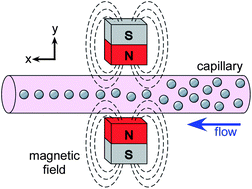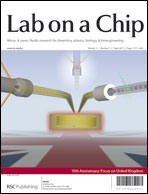Flow focussing of particles and cells based on their intrinsic properties using a simple diamagnetic repulsion setup†
Abstract
The continuous flow focussing and manipulation of particles and cells are important factors in microfluidic applications for performing accurate and reproducible procedures downstream. Many particle focussing methods require complex setups or channel designs that can limit the process and its applications. Here, we present diamagnetic repulsion as a simple means of focussing objects in continuous flow, based only on their intrinsic properties without the requirement of any label. Diamagnetic polystyrene particles were suspended in a paramagnetic medium and pumped through a capillary between a pair of permanent magnets, whereupon the particles were repelled by each magnet into the central axis of the capillary, thus achieving focussing. By investigating this effect, we found that the focussing was greatly enhanced with (i) increased magnetic susceptibility of the medium, (ii) reduced flow rate of the suspension, (iii) increased particle size, and (iv) increased residence time in the magnetic field. Furthermore, we applied diamagnetic repulsion to the flow focussing of living, label-free HaCaT cells.

- This article is part of the themed collection: 10th Anniversary Issue: UK

 Please wait while we load your content...
Please wait while we load your content...